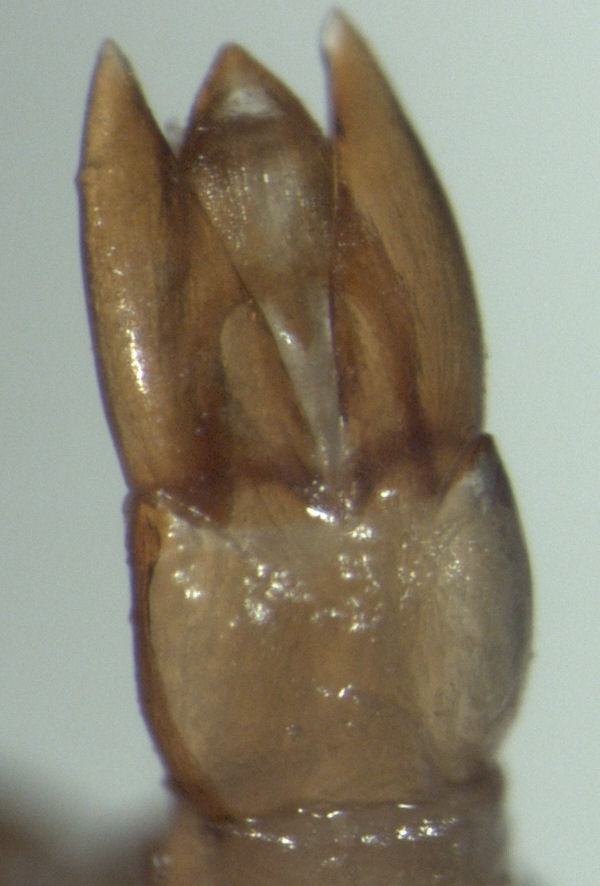Aedeagus on:
[Wikipedia]
[Google]
[Amazon]

 An aedeagus ( or aedeagi) is a reproductive organ of male
An aedeagus ( or aedeagi) is a reproductive organ of male

 An aedeagus ( or aedeagi) is a reproductive organ of male
An aedeagus ( or aedeagi) is a reproductive organ of male arthropod
Arthropods ( ) are invertebrates in the phylum Arthropoda. They possess an arthropod exoskeleton, exoskeleton with a cuticle made of chitin, often Mineralization (biology), mineralised with calcium carbonate, a body with differentiated (Metam ...
s through which they secrete sperm
Sperm (: sperm or sperms) is the male reproductive Cell (biology), cell, or gamete, in anisogamous forms of sexual reproduction (forms in which there is a larger, female reproductive cell and a smaller, male one). Animals produce motile sperm ...
from the testes
A testicle or testis ( testes) is the gonad in all male bilaterians, including humans, and is homologous to the ovary in females. Its primary functions are the production of sperm and the secretion of androgens, primarily testosterone.
The ...
during copulation with a female. It can be thought of as the insect equivalent of a mammal's penis, though the comparison is fairly loose given the greater complexity of insect reproduction. The term is derived .
The aedeagus is part of the male's abdomen
The abdomen (colloquially called the gut, belly, tummy, midriff, tucky, or stomach) is the front part of the torso between the thorax (chest) and pelvis in humans and in other vertebrates. The area occupied by the abdomen is called the abdominal ...
, which is the hindmost of the three major body sections of an insect. The pair of testes
A testicle or testis ( testes) is the gonad in all male bilaterians, including humans, and is homologous to the ovary in females. Its primary functions are the production of sperm and the secretion of androgens, primarily testosterone.
The ...
of the insect are connected to the aedeagus through the genital ducts. The aedeagus is part of the male insect's phallus, a complex and often species-specific arrangement of more or less sclerotized (hardened) flaps and hooks which also includes in some species the valvae (clasper), which are paired organs which help the male hold on to the female during copulation. During copulation, the aedeagus connects with the ovipore of a female. The aedeagus can be quite pronounced or ''de minimis''.
The base of the aedeagus may be the partially sclerotized phallotheca, also called the
phallosoma or theca. In some species the phallotheca contains a space, called the endosoma (internal holding pouch), into which the tip end of the aedeagus may be withdrawn (retracted). The vas deferens is sometimes drawn into (folded into) the phallotheca together with a seminal vesicle.
In some arthropod
Arthropods ( ) are invertebrates in the phylum Arthropoda. They possess an arthropod exoskeleton, exoskeleton with a cuticle made of chitin, often Mineralization (biology), mineralised with calcium carbonate, a body with differentiated (Metam ...
s, sperm is not passed to the female as liquid with free-swimming spermatozoa
A spermatozoon (; also spelled spermatozoön; : spermatozoa; ) is a motile sperm cell (biology), cell produced by male animals relying on internal fertilization. A spermatozoon is a moving form of the ploidy, haploid cell (biology), cell that is ...
, but as capsules called spermatophore
A spermatophore, from Ancient Greek σπέρμα (''spérma''), meaning "seed", and -φόρος (''-phóros''), meaning "bearing", or sperm ampulla is a capsule or mass containing spermatozoa created by males of various animal species, especiall ...
s in which the actual spermatozoa are enclosed. In addition to the spermatophores, in some species
A species () is often defined as the largest group of organisms in which any two individuals of the appropriate sexes or mating types can produce fertile offspring, typically by sexual reproduction. It is the basic unit of Taxonomy (biology), ...
the aedeagus also discharges a spermatophylax, a ball of nutritious
Nutrition is the biochemical and physiological process by which an organism uses food and water to support its life. The intake of these substances provides organisms with nutrients (divided into macro- and micro-) which can be metabolized t ...
secretions, as a nuptial gift to aid the female in producing offspring.
In males of most species of Lepidoptera
Lepidoptera ( ) or lepidopterans is an order (biology), order of winged insects which includes butterflies and moths. About 180,000 species of the Lepidoptera have been described, representing 10% of the total described species of living organ ...
, the aedeagus has a sheath which is supported by an organ called the juxta, which is located between the aforementioned valvae.
See also
* for spermatophore transfer in arachnidsReferences
{{reflist Animal reproductive system Sex organs Insect anatomy